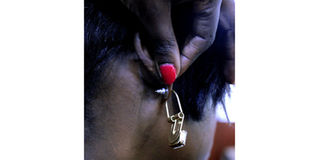Ear piercing: How to prevent complications

It is reccomended that if you have a reaction to any metal used in your ears then you must stop using it and visit a doctor. Photo by Rachel Mabala
After several months of not wearing ear pins, my piercings almost blocked. I turned to nature to get pins. As such, I plucked grass usually collected to make brooms and dried it. Upon drying, I clipped it with a nail cutter and into my ear holes I pushed them.
The force of pushing in blunt sticks caused wounds. Before long, I started feeling an irritation around my ears that would later spread to my jawbone area, below the chin and to my chest. Thankfully, an antihistamine and tablets helped to clear the allergic reaction.
Ear piercing, according to Dr Franklin Wasswa, a general practitioner at Entebbe General Hospital, is literally creating a wound and preventing it from healing because naturally, wounds would heal and close.
“When you puncture through the ear lobe, you have to insert a retainer in that puncture to keep it from closing up after healing. If the puncture is done medically, sterile procedures are practiced and usually metal retainers are left in the hole for at least four to six weeks for complete healing to take place,” he shares.
Before piercing
However, before you get your ears pierced, Dr Malik Sempereza of Unity Skin Clinic, advises that you do some research on the person who will pierce your ears.
“Ask questions such as; what is their track record? How long have they been doing this? Is their place of work clean? Ask them as many questions as possible to give you assurance of desired results,” Dr Sempereza says adding that it is better to be safe than sorry.
Materials put in the ear piercing
The retainers should be gold coated or stainless steel. Dr Wasswa says this is because there are very few or no known allergies to stainless steel or gold coat to skin unlike nickel.
There is a tendency of many women just like myself to put grass sticks but Dr Sempereza says:
“I do not advise any woman to do this as sticks carry infection risks for you. They also have tiny fragments that cause injury.”
“If you insert anything that is bacteria friendly, such as dried grass sticks, you will get infections. These sticks also cause allergic reactions (contact dermatitis),” Dr Wasswa adds.
He further explains that what makes the grass bacterial friendly hence causing infections is the fact that they have micro grooves or natural occurring scratches on their surfaces that aid bacterial growth.
In regards to an allergic reaction, Dr Wasswa says it is contact dermatitis.
“In the modern world, the reaction will be with compounds such as nickel, while for us it will be with grass sticks. Those allergic to grass will usually react when they are in a place where grass has been cut,” he says. This reaction is explained in an easy way like this....
“Your body looks at the grass as an invader such as a virus or bacteria. So it calls in all the protective mechanisms to protect you from the “attack”. Usually, for any allergic reaction, there will be a starting point before spreading. So, if one is allergic to grass yet puts in their ear, the blood circulating past that earlobe, takes a sample of the environment from that lobe, past the lymph nodes, gate keepers monitoring any kind of infection or status of infections in the body,” Dr Wasswa says, adding that these call in the defense mechanism (histamines) that cause all the inflammatory reaction such as swelling, burning pain and itching.
Family history
Some people have no clue about what they might be allergic to. So, Dr Sempereza advises them to look into their family history. “If you have close relatives with sensitive skin, you are also likely to react,” he says. He adds that if you have reacted to metals such as watches, buttons or belts, chances to react also increase with repeated contact.
Keloids
Apart from itching and allergic reactions, ear piercing can also come with thick scars known as keloids.
“It comes with knowing your personal skin history. If you have a history of forming keloids, I advise you to avoid piercing. Even when it is a close family member with keloids, there is a risk of you developing them,” Dr Wasswa advises.
Treatment
In case of itching and allergic reactions, Dr Wasswa says there is need to calm down the inflammatory system which involves different chemicals in the body that mediate it such as histamines.
“The most common medications are antihistamine creams, and steroids which are topical (applied locally). However, when the effect is extensive, a medical practitioner will give you tablets as well,” he say.
He, however, advises against self-medicating, emphasising that for proper diagnosis and treatment, one must see a doctor.




